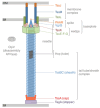Structure and Activity of the Type VI Secretion System
- PMID: 31298206
- PMCID: PMC10957189
- DOI: 10.1128/microbiolspec.PSIB-0031-2019
Structure and Activity of the Type VI Secretion System
Abstract
The type VI secretion system (T6SS) is a multiprotein machine that uses a spring-like mechanism to inject effectors into target cells. The injection apparatus is composed of a baseplate on which is built a contractile tail tube/sheath complex. The inner tube, topped by the spike complex, is propelled outside of the cell by the contraction of the sheath. The injection system is anchored to the cell envelope and oriented towards the cell exterior by a trans-envelope complex. Effectors delivered by the T6SS are loaded within the inner tube or on the spike complex and can target prokaryotic and/or eukaryotic cells. Here we summarize the structure, assembly, and mechanism of action of the T6SS. We also review the function of effectors and their mode of recruitment and delivery.
Figures



References
Publication types
MeSH terms
Substances
LinkOut - more resources
Full Text Sources

